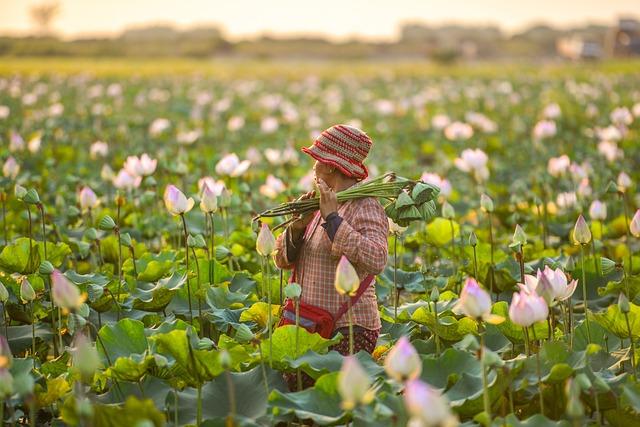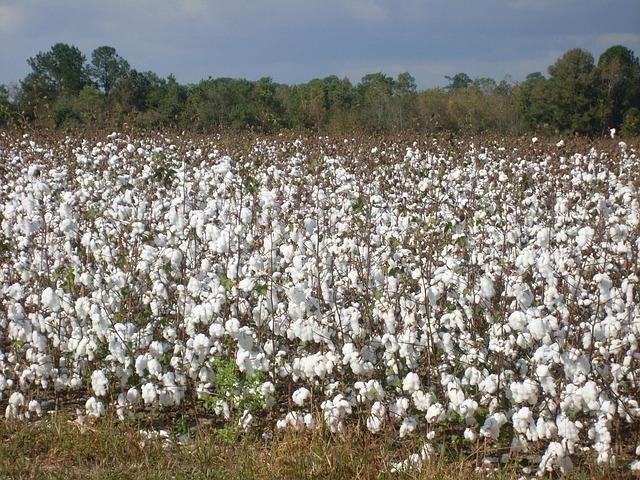Advent
Mali, a landlocked country in West Africa, has not too long ago completed a exceptional milestone in its agricultural sector, marking an important build up in cotton manufacturing. In keeping with studies from Africanews, this surge no longer onyl highlights the nation’s agricultural attainable but in addition underscores the crucial position of cotton as a primary money crop that drives the financial system. As Mali objectives to strengthen its place within the world cotton marketplace,quite a lot of components akin to favorable weather conditions,improved farming techniques,and govt beef up have contributed to this spectacular manufacturing fee. This article delves into the consequences of Mali’s report cotton output, exploring its have an effect on on native farmers, the financial system, and sustainable agricultural practices in the area.
Mali Achieves File Cotton Manufacturing Amid International Marketplace Adjustments
Mali’s agricultural sector is celebrating an important milestone as the rustic achieves its easiest cotton manufacturing ranges to date, regardless of navigating an more and more unpredictable world marketplace. This success will also be attributed to a number of key components together with favorable climate stipulations, stepped forward agricultural tactics, and govt beef up geared toward bolstering the cotton trade. The hot investments in seed high quality and pesticide control have additionally performed a an important position in bettering yields, permitting native farmers to supply extra cotton than ever ahead of.
As world call for for cotton stays unstable, Mali’s good fortune might function a benchmark for different generating international locations. Whilst the marketplace is influenced through converting shopper personal tastes and international trade agreements, the nation is having a look to capitalize on its productive capability. This manufacturing growth no longer simplest guarantees to strengthen Mali’s financial system via greater exports but in addition objectives to fortify the livelihoods of the farmers concerned. Key highlights of this 12 months’s manufacturing come with:
- Overall Cotton Output: File-breaking figures surpassed earlier years.
- Farmer Participation: Larger numbers of smallholder farmers engaged in cotton cultivation.
- Export Alternatives: New markets being explored amid fluctuating world costs.
| Yr | Cotton Manufacturing (lots) |
|---|---|
| 2020 | 100,000 |
| 2021 | 125,000 |
| 2022 | 150,000 |
| 2023 | 180,000 |

Financial Have an effect on of Larger Cotton Yields on mali’s Agricultural Sector
The surge in cotton yields has substantial implications for Mali’s agricultural sector, which is predicated closely on cotton as a staple money crop. Upper cotton manufacturing results in enhanced source of revenue for farmers, letting them reinvest of their farms and communities. This interprets into quite a lot of certain results, together with:
- Larger Employment: As cotton manufacturing expands, the call for for exertions rises, resulting in extra task alternatives in rural spaces.
- Progressed Infrastructure: extra earnings from cotton can facilitate higher roads, irrigation, and amenities, reaping benefits a couple of sectors.
- Funding in Sustainable Practices: Upper earning allow farmers to undertake environmentally amiable practices that may improve yields additional and give protection to the ecosystem.
Additionally, the upward trajectory of cotton yields is extremely more likely to bolster Mali’s place within the world cotton marketplace. With the suitable methods in position, the rustic can improve its export attainable, offering a strong supply of overseas alternate. The following desk illustrates the projected have an effect on of greater yields on key financial signs:
| Indicator | Present Standing (2023) | projected Have an effect on (2025) |
|---|---|---|
| Cotton Yield (lots/hectare) | 1.5 | 2.0 |
| Export Income (in million $) | 200 | 300 |
| Employment Fee in Cotton Sector | 15,000 jobs | 20,000 jobs |
This dynamic enlargement no longer simplest uplifts Mali’s financial system however additionally performs a an important position in making improvements to the dwelling requirements of its farmers, fostering an atmosphere have been agricultural innovation can thrive.

Demanding situations Dealing with Mali’s Cotton Farmers in a Aggressive Setting
The cotton farming sector in Mali faces a large number of hurdles as it strives to deal with its standing as a number one manufacturer in Africa. Whilst the country has completed report outputs, farmers are grappling with a myriad of demanding situations, together with variable local weather stipulations that can considerably have an effect on crop yields. The unpredictability of rainfall patterns and greater cases of drought have created apprehension amongst farmers referring to their skill to maintain productiveness. Moreover, the have an effect on of pests and illnesses has additional strained their skill to compete on a world scale. Farmers incessantly lack get right of entry to to the important assets and beef up for efficient pest control, in the end affecting their harvests and source of revenue.
Additionally, the aggressive panorama of the worldwide cotton marketplace poses threats that don’t seem to be simply mitigated. Manufacturers in international locations with extra complex generation and higher get right of entry to to markets can undercut costs, making it hard for Mali’s farmers to thrive. The demanding situations are exacerbated through restricted get right of entry to to financing, which hinders farmers from making an investment in higher farming tactics and gear. Because of this, Mali’s cotton farmers are incessantly stuck in a cycle of low profitability and excessive dependency on volatile market conditions. to navigate this surroundings effectively, it is certainly crucial for stakeholders to collaborate and increase methods that improve sustainability and make sure honest business practices.

Sustainable Practices in Cotton Cultivation: A Trail Ahead for Mali
Mali’s cotton trade has lengthy been a cornerstone of its financial system, but the escalating demanding situations posed through local weather trade and unsustainable agricultural strategies necessitate pressing shifts in opposition to eco-friendly practices. Embracing sustainable farming tactics guarantees that Mali no longer simplest complements its cotton yield but in addition safeguards its environmental well being for long run generations. Some key sustainable practices that will also be built-in come with:
- Crop Rotation: Diversifying crop manufacturing to repair soil fertility and disrupt pest cycles.
- Natural Fertilizers: Using herbal compost and inexperienced manure to enrich the soil with out chemical dependency.
- Built-in Pest Control (IPM): Using a mix of organic, cultural, and mechanical controls to control pests sustainably.
- Water Conservation Tactics: Enforcing drip irrigation to attenuate water wastage and improve crop resilience towards drought.
Moreover, supporting native farmers via schooling and assets can considerably carry the cotton sector. construction group networks for sustainable practices can advertise wisdom alternate and create a extra resilient agricultural panorama. With ongoing investments in analysis and growth, Mali may increase fiber traits that meet world calls for whilst prioritizing sustainability. The next desk outlines the possible financial advantages of adopting sustainable practices in cotton manufacturing:
| Get advantages | Have an effect on |
|---|---|
| Progressed Soil Well being | Larger productiveness and lowered want for chemical fertilizers. |
| Upper Cotton High quality | Top class pricing on global markets due to sustainable certifications. |
| group Resilience | More potent native economies and lowered poverty ranges amongst farming households. |

Coverage Suggestions to Toughen the Cotton Business’s Enlargement
To maintain and improve the momentum of the cotton trade, it is vital to put in force focused insurance policies that cope with each speedy demanding situations and long-term objectives. Those insurance policies must center of attention on making improvements to get right of entry to to monetary assets for farmers, thereby enabling them to spend money on high quality seeds and trendy agricultural tactics. Moreover, strengthening the infrastructure for cotton processing and exports can a great deal improve competitiveness on world markets. Key suggestions come with:
- Sponsored Get entry to to High quality Inputs: Put in force systems to supply farmers with sponsored seeds and fertilizers.
- Funding in Analysis and Building: Toughen establishments devoted to growing pest-resistant and high-yield cotton types.
- Strengthening Cooperative Fashions: Foster the formation of cooperatives to unify farmers, which is able to improve bargaining energy and scale back prices.
Moreover, construction partnerships between govt our bodies, global organizations, and personal buyers can create a synergetic surroundings to foster enlargement. Public-private partnerships must center of attention on coaching systems that train farmers on sustainable practices and leading edge applied sciences. Moreover, the established order of export incentives can inspire manufacturers through ensuring higher costs for high quality cotton on global markets. A complete way might come with:
| Coverage Initiative | Anticipated Consequence |
|---|---|
| Microfinance Accessibility | Larger farmer funding in manufacturing |
| Trendy Generation Coaching | Enhanced productiveness and sustainability |
| Global Industry Agreements | Expanded marketplace get right of entry to for cotton manufacturers |

Long term Possibilities for Mali’s Cotton Manufacturing within the Face of Local weather Alternate
The longer term of cotton manufacturing in Mali hinges at the agility of its agricultural practices to evolve to the escalating demanding situations posed through local weather trade. Heatwaves, erratic rainfall patterns, and the greater prevalence of pests are reshaping the cultivation panorama. To satisfy those demanding situations, farmers are more and more adopting resilient farming practices akin to:
- Crop rotation to improve soil fertility and scale back pest outbreaks.
- Built-in pest control to attenuate reliance on chemical insecticides.
- Use of drought-resistant cotton types that can face up to harsher rising stipulations.
Additionally, funding in sustainable irrigation applied sciences and agroforestry can additional bolster the resilience of Mali’s cotton sector. Governmental and non-governmental organizations are pivotal on this transformation through offering coaching and assets.A complete way that contains:
| Technique | Get advantages |
|---|---|
| Agroecological tactics | Enhanced biodiversity |
| Funding in analysis | Building of latest crop types |
| Group schooling | Progressed farmer wisdom |
By means of embracing those methods, Mali no longer simplest stands to stabilize its cotton manufacturing but in addition give a contribution considerably to meals safety and financial resilience within the face of an unsure local weather. the proactive engagement of all stakeholders—from farmers to policymakers—will probably be an important in reshaping the cotton trade into a sustainable and thriving sector that aligns with environmental imperatives.
In Conclusion
Mali’s success in recording its easiest cotton manufacturing marks an important milestone for the country, reaffirming its place as a key participant within the world cotton trade. This build up no longer simplest bolsters the nation’s agricultural financial system but in addition underscores the resilience and attainable of Malian farmers within the face of ongoing demanding situations. As Mali continues to improve its manufacturing features, the consequences for each native livelihoods and global markets are profound. The continuing beef up for sustainable agricultural practices and funding in infrastructure will probably be essential in keeping up this upward trajectory. With the arena more and more concerned about sustainable style and textile manufacturing, Mali’s cotton sector stands poised for a promising long run, using financial enlargement and construction for the rustic and its folks.As we watch this area, the worldwide group will indubitably stay a willing eye on Mali’s evolving position in the cotton panorama.
Source link : https://afric.news/2025/03/16/mali-records-highest-cotton-production-africanews-english/
Writer : AfricNews
Submit date : 2025-03-16 18:11:00
Copyright for syndicated content material belongs to the related Source.



